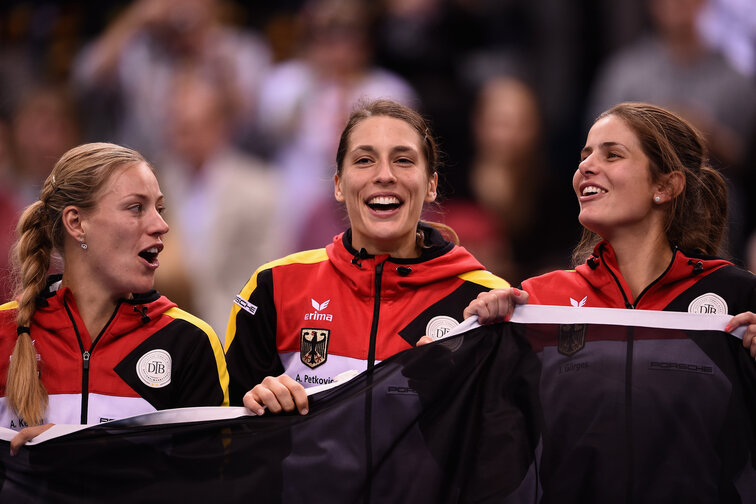Young talent problem in German women's tennis: the big gap behind the golden generation
In German women's tennis, which is used to success, there is a big hole behind the now somewhat older players like Angelique Kerber and Julia Görges . An assessment of the situation in German women's tennis.
by Jörg Allmeroth
last edit:
Oct 07, 2020, 02:49 pm

It was slowly approaching midnight when Daniel Altmaier hit his last balls under the roof of the prettied Paris Center Court on Monday. Altmaier was over-motivated, over-eager, high-spirited, the seventh game in the last 15 days was one too many for the 22-year-old boy from the Lower Rhine. 2: 6, 5: 7, 2: 6 he lost the match in an imposing and oppressive environment against the Spaniard Pablo Carreno Busta, but no cause for greater disappointment and sadness. Altmaier had the expectations, far exceeded the plan for this French Open as a qualifier, and he soon looked confidently into his future career: “It was a great experience to have a taste of the big tour here,” he said, “now I'll be very ready for the next few weeks. "As early as next Monday, Altmaier, just like presumably Alexander Zverev, will be playing at the newly established ATP tournament in Cologne.
Altmaier was - alongside the still active quarter-finalist Laura Siegemund - the German history of this last Grand Slam tournament of the season. A story that, despite all the surprise effects, nevertheless fitted into the picture. Because if in the last few years, long before the Corona era, amazing tennis moments could be marveled at on the larger stages, then they could only be ascribed to German men's tennis. Jan-Lennard Struff, for example, underpinned his late career boom with good Grand Slam results. In 2019, a hands-on player suddenly appeared again, who had found his way into touring through American college tennis - his name: Dominik Koepfer. At the US Open a year ago, the Black Forest player advanced to the round of 16 as a qualifier, only failing when Daniil Medvedev (Russia) later participated in the final. And then there were Kevin Krawietz and Andreas Mies, the two sky-strikers, who crowned their very fresh alliance with the French Open title coup.
Gap behind Kerber, Görges & Co
And after all that, where were the German tennis ladies, what was and what has become of the German fräuleinwunder? Of course, some bang effects can never be completely ruled out, but it seems as if the golden generation with Angelique Kerber, Julia Görges and Andrea Petkovic have had the very best days. And just as much one can assume that successes such as Kerber's in particular at Grand Slam festivals around the world will initially not materialize. Behind Kerber and Co. there is a big gap in performance, especially in the generation between 25 and 30 years of age. Siegemund also belongs more to the establishment, and in terms of age, not to those who can still ensure black, red and gold moments of success in the long term.
However, some companions and young players could take an example from the indefatigable Swabian, after all, against some expectations, Siegemund managed to break through to the top of the world late against some expectations. And then don't let yourself be swayed by many, many setbacks. At the age of 32 she is celebrating her best season, the double title in New York was the high point of an eventful career so far. Too many other talents in German women's tennis have been lost in recent years, however, the once highly traded Hamburg-based Carina Witthöft took an indefinite break from the tour scene - she couldn't cope with either her own or public expectations.
No German U-30 player in the top 100
Annika Beck from Bonn, one of the best in the world as a junior, said irrevocably goodbye to professional tennis and instead began studying medicine. Antonia Lottner, who was also among the top tennis players in the world as a teenager, has disappeared into no man's land, she is currently ranked 173 in the world. There is no German player under 30 among the top 100 of the WTA charts, the best German under 25, the 22-year-old Katharina Gerlach, even only appears at position 243. There is no longer any sign of German Sturm und Drang under the age of 20, as was once the case with Steffi Graf. And this also fits into the frustrating overall picture, the sad story of Sabine Lisicki from Berlin, who is repeatedly plagued by injuries and the Wimbledon finalist from 2013. The physically ailing top force of yore is ranked 687 with a world ranking point, comeback very uncertain .
DTB department head Barbara Rittner had already identified a “frightening overall picture” for her work area in 2019 and earlier this season. She is afraid of the moment "when the Kerbers and Görges´ will leave". And you have to admit that "the connection to the international top level has been lost." Rittner is now already relying on the very young, the 16 to 18 year old players. “Miracles are not to be expected at first, we need a lot of patience”, she says, “we will definitely offer you full throttle support for your career.” The goal? "Introduce the best talents to professional operations as quickly and as carefully as possible."
rg2020
